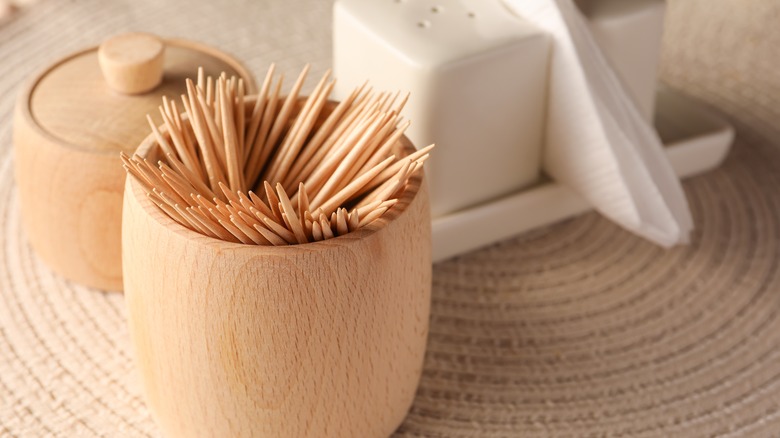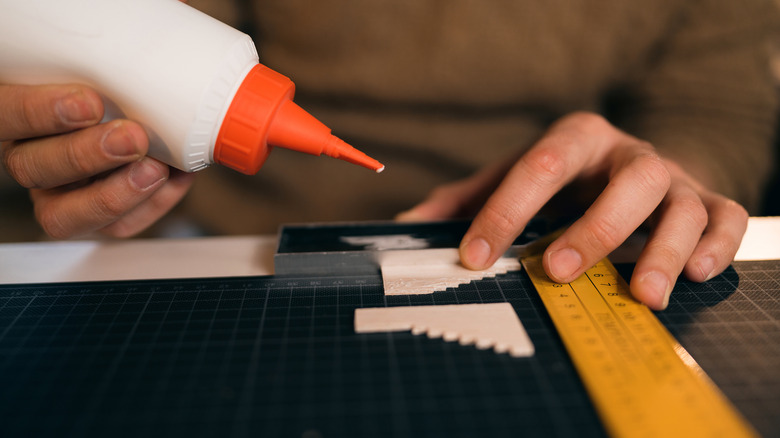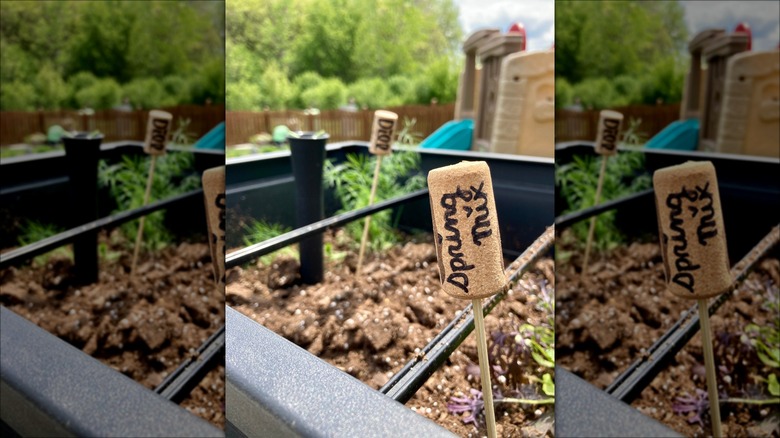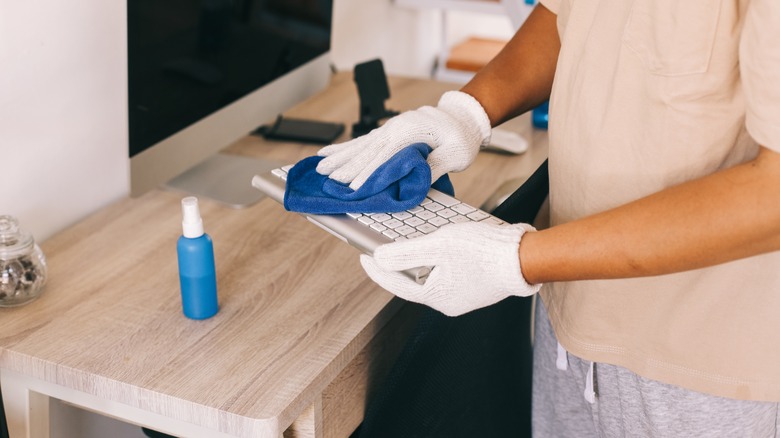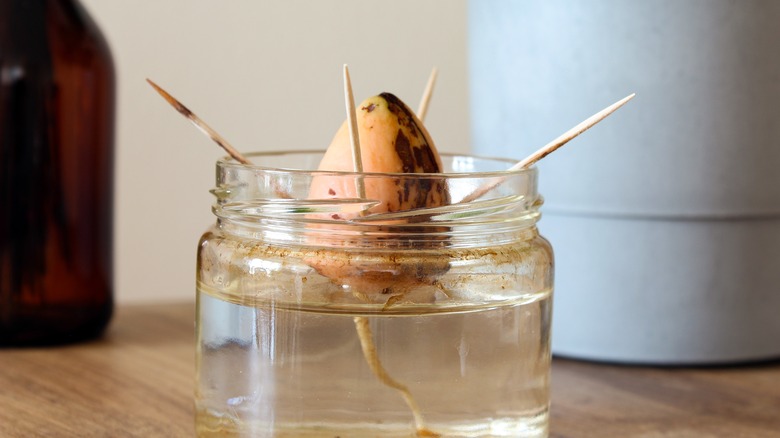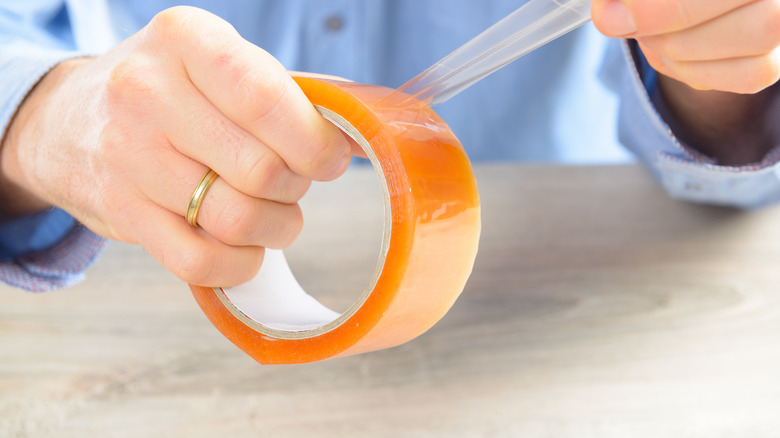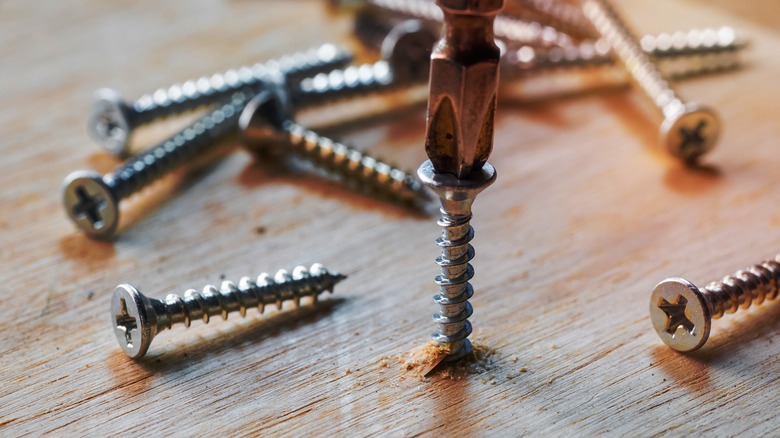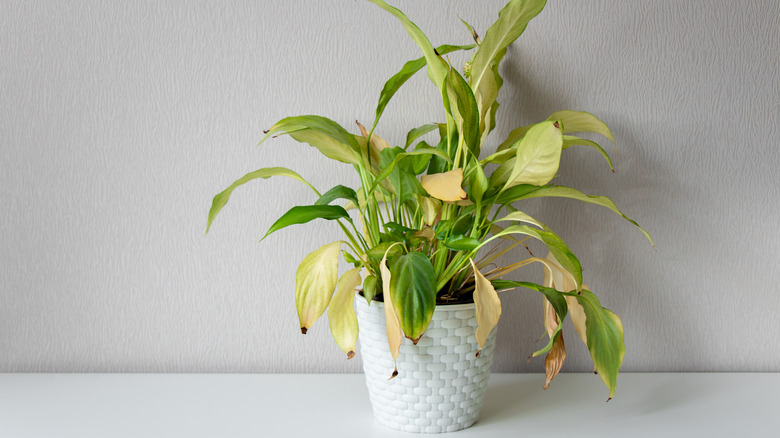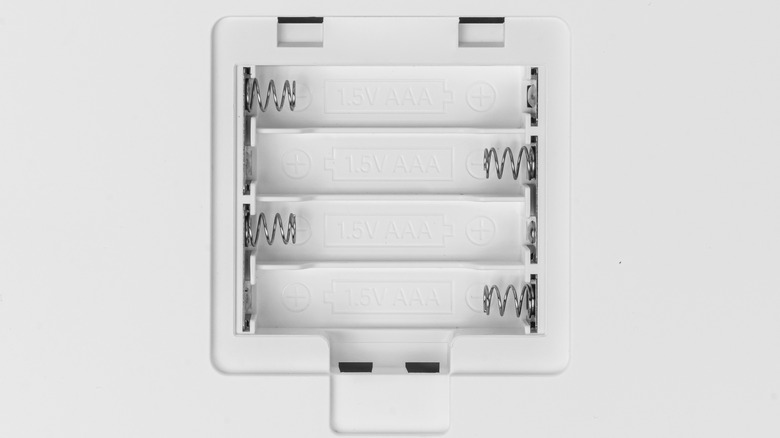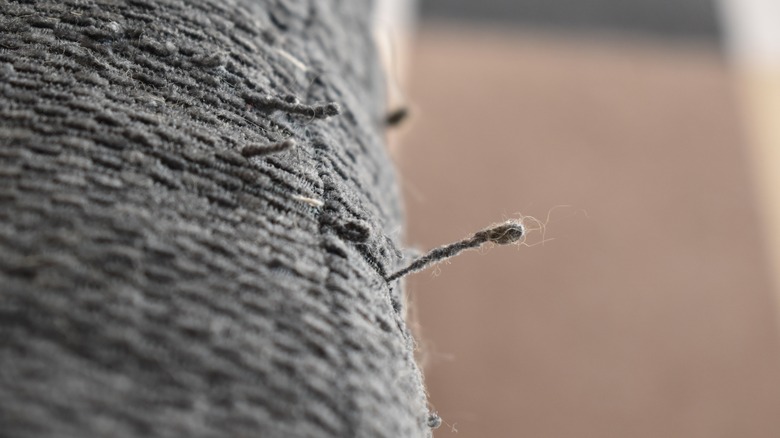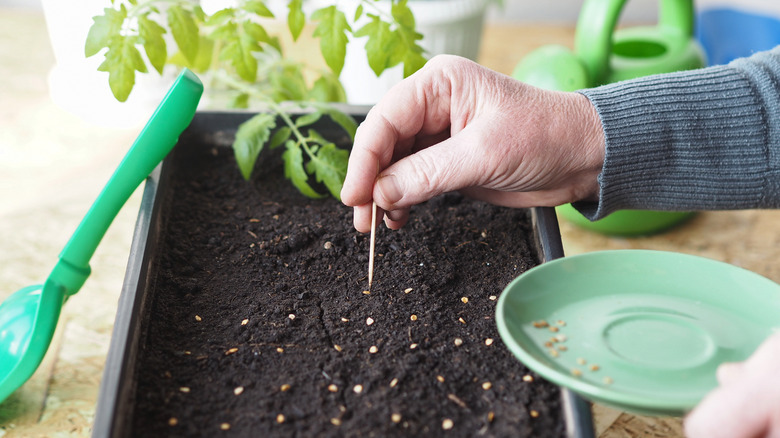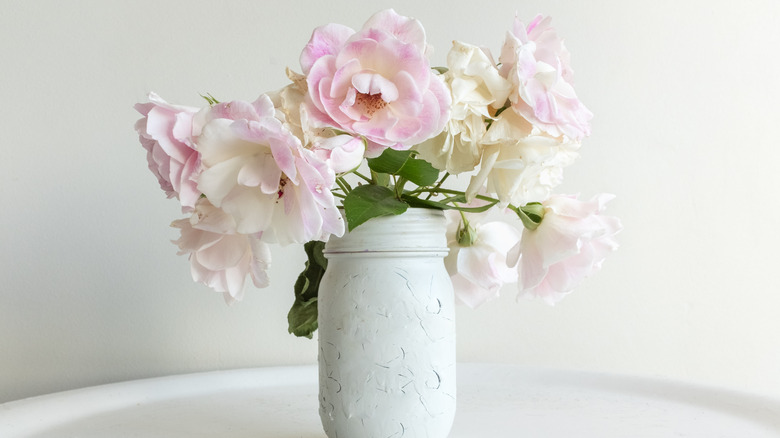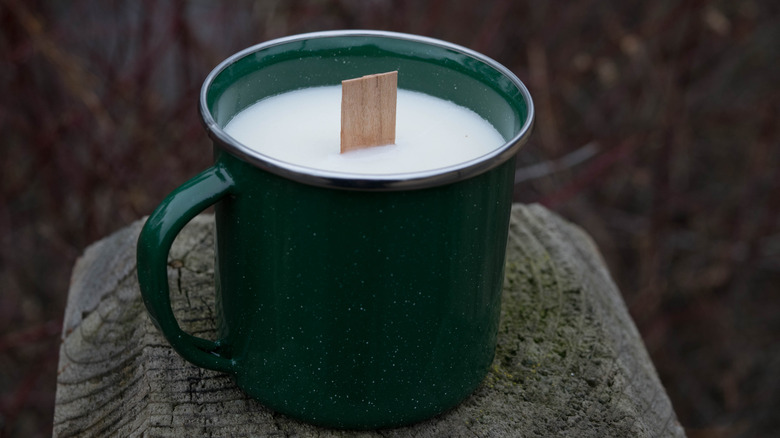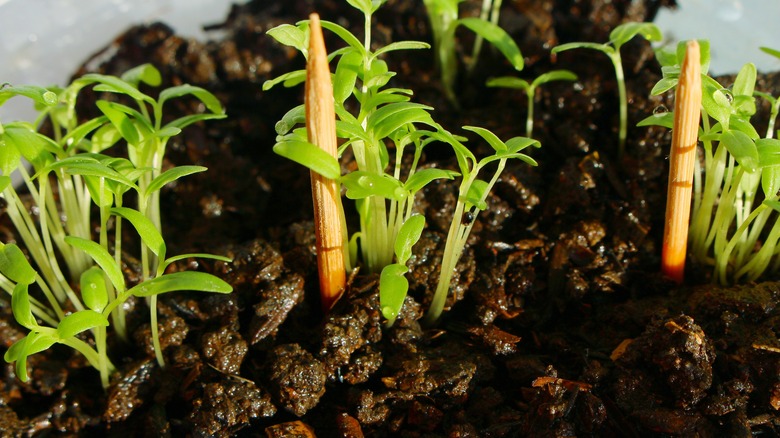17 Clever Ways To Repurpose Toothpicks Around Your Home And Garden
Toothpicks are one of those miscellaneous items that you might not routinely reach for, but you find that you need more often than not. Even if you don't use them for their intended purpose of dislodging food from your teeth — not always a good idea, according to some dentists, as repeated use can cause damage to your gums — there are still plenty of different applications for these simple little wooden sticks around the house. Most people know that toothpicks can be used to serve hors d'oeuvres or keep the contents of a particularly hefty sandwich from slipping and sliding around, but there are quite a few other ideas that you might not have considered.
With a little bit of creativity, you can use these junk drawer staples as a substitute for plenty of other items, helping to save you both money and effort. Their small size and simple construction make them the perfect fit for a wide variety of tasks, the pointed end means they can easily pierce soft surfaces and fit into small spaces, and the fact that they're disposable and made of wood means they can help you avoid annoying cleanups without having to rely on something that isn't easily biodegradable, like plastic. All in all, these ideas should help make your life just a little bit easier, something that we can all appreciate.
Unclog nozzles
Toothpicks were designed to get into the nooks and crannies of your teeth to help clear away stubborn food, but their small size and pointy shape also make them well-suited to complete other similar tasks. If you find yourself with a bottle that has a small nozzle, like school glue or dye applicators, and you need something to help clear it out, a toothpick is the perfect choice for the job. Either stick the toothpick in the hole to help open it back up, or use it to help pick out any bits of debris that might have dried up and started to block the product's flow.
Plant markers
For much of a plant's lifespan, it will either be completely invisible under the surface of the soil or look nearly identical to the other things you have growing around it. Because of this, plant markers are an absolute necessity, at least until your plant reaches full maturity and starts to become more easily identifiable. Luckily, you can make markers out of just about anything, and toothpicks are no exception. Attach a cork, a small piece of cardboard, or some scrap wood with the name of the plant to a toothpick, then stick it in the soil to act as a guide in your garden.
Paint fine details
Because they're so small and easily disposable, toothpicks make for a great substitute for a tiny paintbrush. This obviously applies to crafting projects and more artistic DIYs — they're great to stencil on tiny patterns or get into nooks and crannies where you're trying to be ultra-precise — but they can also be helpful when it comes to more utilitarian paint jobs, too. For example, if you're trying to cover up a pin hole or correct a small scuff on your wall, consider grabbing a toothpick instead of a brush. This way, you can have precise control of your application and don't have to wash anything when you're done.
Clean your computer's keyboard
It's a simple fact: no matter how hard you try to keep your workspace clean, you'll always end up with at least a couple of crumbs in your keyboard. Regular wipe-downs with a cloth and some isopropyl alcohol can help to keep any dust and surface debris from building up, but this simple cleaning strategy only scratches the surface. If you need a more precise clean, it's time to break out the toothpicks. Use your toothpick to carefully free any trapped crumbs from under and around your keys, then give everything one final wipe. In a couple of minutes, your keyboard should look like new.
Grow avocados from seed
Growing plants from seed rather than buying them already established from a nursery can both save you money and help make the end result even more rewarding. This is doubly true when you decide to grow your own fruiting plant, like an avocado tree, from the leftovers you have from your last grocery trip. While your homegrown avocado plant will likely take years to produce fruit, if it ever does, watching the seed sprout and develop into a plant is still a rewarding and educational experiment. Soak your seed, remove the outer coating, then use toothpicks to suspend it over water and watch the magic happen.
Light candles
If you frequently find yourself burning scented candles, you've likely faced the struggle of trying to reach the very bottom of the jar once the wax starts to approach the end of its life. This isn't much of an issue if you're using a utility lighter or long match, but if you only have a pocket lighter, you might find yourself having to awkwardly maneuver and even risk burning yourself to reach the wick. In this situation, consider using a toothpick to more easily transfer the flame. Light the end of your toothpick, then use it like a match to ignite the wick.
Mark tape
Clear tape is great if you need to tape down a label and still see what's underneath or don't want your repair job to look so obvious, but it can present a pretty inconvenient challenge when you have to scour the roll for a nearly invisible seam every time you use it. For an easy way to mark the end of your roll, try using a toothpick. Before you put away your tape, stick a toothpick to the sticky side of the tape at the end of the roll. When you want to use it again, pull the toothpick for a hassle-free way to get it started.
Fix a stripped screw hole
After drilling into the same spot a couple of times, especially if you're using a thicker screw, you might find that you've created a hole so large that the screw will no longer properly latch on. Luckily, however, there's a way to repair this issue, and all it takes is a toothpick. Stick a toothpick in the hole, then draw a line to mark how deep the hole is. Cut the toothpick down, put it in the hole, then drill into the spot as normal. The toothpick will fill the space and give the screw material to latch on to, meaning it should stay secure.
Clean your phone
As technology advances, the parts needed to make our electronics serve their purpose have grown smaller and smaller. This is more convenient, of course — it's nice not hauling around a bulky speaker to play music, for example — but it can get annoying when it comes time to clean. All those little nooks and crannies on your phone, like the speaker, power socket, and volume buttons, can collect debris with use. To give them a deep clean, try using a toothpick to get in those hard-to-reach areas and ensure your phone stays clean and functional, even when you use it every day.
Straighten plant stems
Even the most dedicated plant parents occasionally have to face the struggle of a plant with a broken or sagging stem, but, fortunately, not all hope is lost. If your plant's stem isn't completely snapped off and just looks like it needs a little help, try making a splint out of some toothpicks. Tape it to the area that needs some more structure, and, as it continues to grow, it should start to heal and repair itself. This little split essentially acts like a cast would for a broken limb — it won't do any of the healing work, but it can certainly help to move it along.
Apply glue
Most of the time, when you're using glue in your DIY projects, it doesn't take a lot to get the job done. Because of this, it's easy to glob on too much, leaving you with unwanted residue once everything dries down. If you want more control over your application, a toothpick can help. Dab out a bit of glue onto something you're not worried about damaging, like a piece of scrap cardboard or plastic, then dip the end of the toothpick. Use the toothpick to apply your glue rather than the nozzle of the bottle, and you won't have to worry about excess product.
Open stubborn slots
Even items that are designed to be as user-friendly as possible can cause the occasional issue, especially when it comes to removing pieces or accessing areas that you likely don't need to open every day. Battery slots for toys, for example, are notoriously difficult to pry open, and tiny pieces of material that protect SD cards or game cartridges can feel comically small when you try to handle them. Those with smaller hands or long nails have a slight advantage here, but, if you need some extra help and aren't looking to get a manicure anytime soon, a toothpick can make the job much easier.
Fix snags in upholstery
If you have pets, you know that the occasional snag in the fabric pieces around your house is inevitable. Even with routine trimmings and impeccable training, claws will invariably cause a small amount of damage to woven fabrics. Thankfully, however, the fabrics used for upholstery on sofas, pillows, and even heavier curtains are usually pretty durable, so all they need is a bit of finessing to look brand new again. The next time you notice a snag, grab a toothpick and push the loose thread back into the fabric. It might not be a perfect fix, but it will make the damage much less visible.
Plant and place small seeds
Starting seeds at home has plenty of benefits, but, even for the most experienced gardeners, some of the tasks can get a bit fiddly. Namely, handling and planting small seeds. If you're looking for a way to more precisely space out and plant your seeds when they seem nearly impossible to grab with your bare hands, try using a toothpick. Slightly wet the end, then dump your seeds onto a plate or other similar flat surface. Use the wet end of the toothpick to stick to the seeds, and you'll have more control over where you can place them on the soil.
Straighten sagging flowers
After a few days of sitting in a vase, it's not uncommon for flower stems to begin to sag and droop. If you've done all you can to keep your cut flowers fresh longer and they're still looking a bit sad, it might be time to call in some toothpick reinforcements. In a similar way to how you'd create a splint for a damaged plant, tape a couple of toothpicks to the stem of your sagging flower to hold it straight out and correct the curve. Eventually, the stem will still start to wither, but this can give you an extra few days of upstanding blooms.
DIY candle wick
It might seem like a bit of a strange idea at first, but, it turns out, that toothpicks can act as a solid substitute for a candle wick with the proper treatment. To make your own wood wick, soak your toothpicks in wax until it has absorbed into the wood fully. After it has cooled and hardened, glue it down to the bottom of your vessel to ensure it doesn't move around. Because toothpicks are stiff, you don't have to worry about wrapping the wick around something to keep it straight. Pour your wax, allow it to cool, and you're all set to light your new homemade candle.
Check soil moisture levels
You might already know that you can use a toothpick to check to see if your baked goods are ready to pull out of the oven, but did you know that you can use a similar process to tell if your plants need water? If you want to see if the plant's soil is saturated beyond the top layer, stick a natural wooden toothpick a couple of inches deep and leave it there for a few minutes. Remove it, and, if you notice that the wood has slightly swollen or changed color, you will know that the soil is wet and doesn't need watering.
